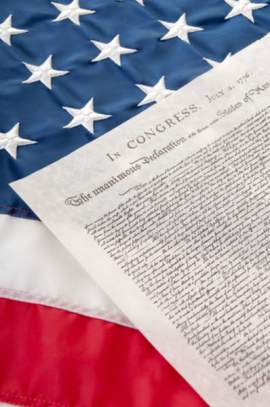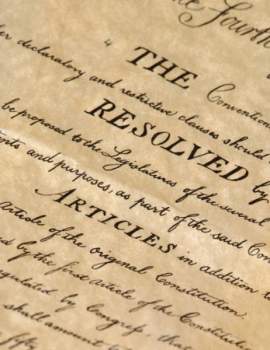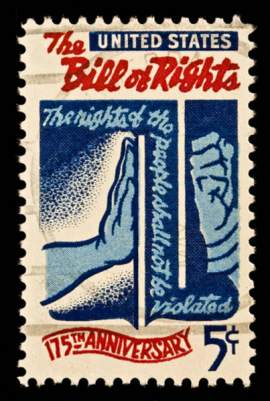
What Are The Procedures When Majority is Not Met

Popular In Constitution
Purpose Of Lifetime Appointment And Pros And Cons Enumerated Powers Bicameral Legislature Background Article 3 Of The Constitution We The People 1st Amendment Who Wrote The Constitution Judicial Review Equal Protection Clause Three Fifths Compromise 10th Amendment 5th Amendment
The electoral college system of America requires a candidate to obtain an absolute majority in order to become elected to the presidency. To have an absolute majority means that the candidate has over half of the total possible votes, which is different from a simple plurality, which only would require that a candidate have the most votes out of all the candidates. This necessity for an absolute majority means that, while such occurrences are rare, it is possible for no candidate to win the election, as no candidate could successfully achieve the absolute majority necessary. Such situations were anticipated by the Constitution's framers, however, and some provisions and procedures were laid out to determine how such a problem should be solved.
The electoral college system was designed so that a candidate would have to achieve an absolute majority in order to prevent one candidate becoming the President of the entire nation simply because he received all the votes from his home area, which were enough to put him over the other candidates. Requiring an absolute majority ensures that over half of the nation would have voted for that candidate, although the exact proportion would vary depending on a number of different statistics. But because the American system is also not a definitively two party system and does allow for any number of possible parties to run, the available electoral votes might be split between enough parties so as to prevent any one candidate from achieving that absolute majority.
This was most likely one of the primary worries of the framers of the Constitution with regard to the electoral college system, as there were no parties or clear political organizations at the time they were writing the Constitution and they could not have been certain that hundreds of different candidates would try to run and would each eat up just enough votes to prevent any one candidate from successfully winning the presidency. As such, they included a contingency in Article 2 of the Constitution which would dictate proper procedure in such situations. Specifically, the House of Representatives would perform a vote to determine the President. This system was further refined after the election of 1800 with the Twelfth Amendment. To find out more about the base system for solving the problem of no absolute majority, follow the link.
The election of 1800 was a very significant election, primarily because it perfectly demonstrated one of the unforeseen problems of the original electoral college system. In the original system as set forth in the Constitution itself, each elector in the electoral college would actually issue two votes for President. The Vice President would be the candidate who won the second most number of electoral votes after the President, who must still have had an absolute majority. But in the election of 1796, this led to members of opposing parties becoming the President and the Vice President. While this was not an insurmountable problem, it did make it difficult for the President and Vice President to work together easily.
In the election of 1800, however, a more significant problem arose. The supposed candidates for the presidency and the vice-presidency from the same party actually earned the same number of electoral votes, thus meaning that it was unclear to whom the presidency should go. Because there were no outright vice-presidential candidates, and all candidates were presidential candidates, then the situation was treated as if two presidential candidates had tied and it went to the House of Representatives for a vote, even though all involved knew that one of the two candidates had been originally intended as the vice-presidential candidate. This election led to the adoption of the Twelfth Amendment, which provided for electors to vote for one presidential candidate and one vice-presidential candidate. For more information on the election of 1800 and its legacy, click the link.
The election of 1824 was actually something of a proof of the efficacy of the system for dealing with an absence of absolute majority. In this election, there were four different candidates from the same party, each of whom took some of the votes away from the others. As a result, no candidate won a majority. This was different from the election of 1800, in that no two candidates actually tied. Andrew Jackson was the front runner in terms of electoral votes and in terms of popular votes as well. He simply did not win enough electoral votes to be considered to have won an absolute majority. As a result, the decision to determine the disposition of the presidency went to the House of Representatives.
In this case, however, the House made a decision which most did not anticipate. One of the four candidates, Henry Clay, could not be considered in the House's decision because the House can only choose between the top three recipients of electoral votes. As such, Henry Clay was out of the running and he threw his support behind another candidate, John Quincy Adams. With Clay's support, Adams was able to edge out Jackson in the House vote and successfully won the presidency. This election showed that the system in place for dealing with the absence of an absolute majority would function, even if the system's integrity was debatable, as Jackson would have argued. To learn more about Jackson's problems with the outcome of this election, and about the election in general, follow the link.
NEXT: What Does It Mean To Reach Proper Majority




















